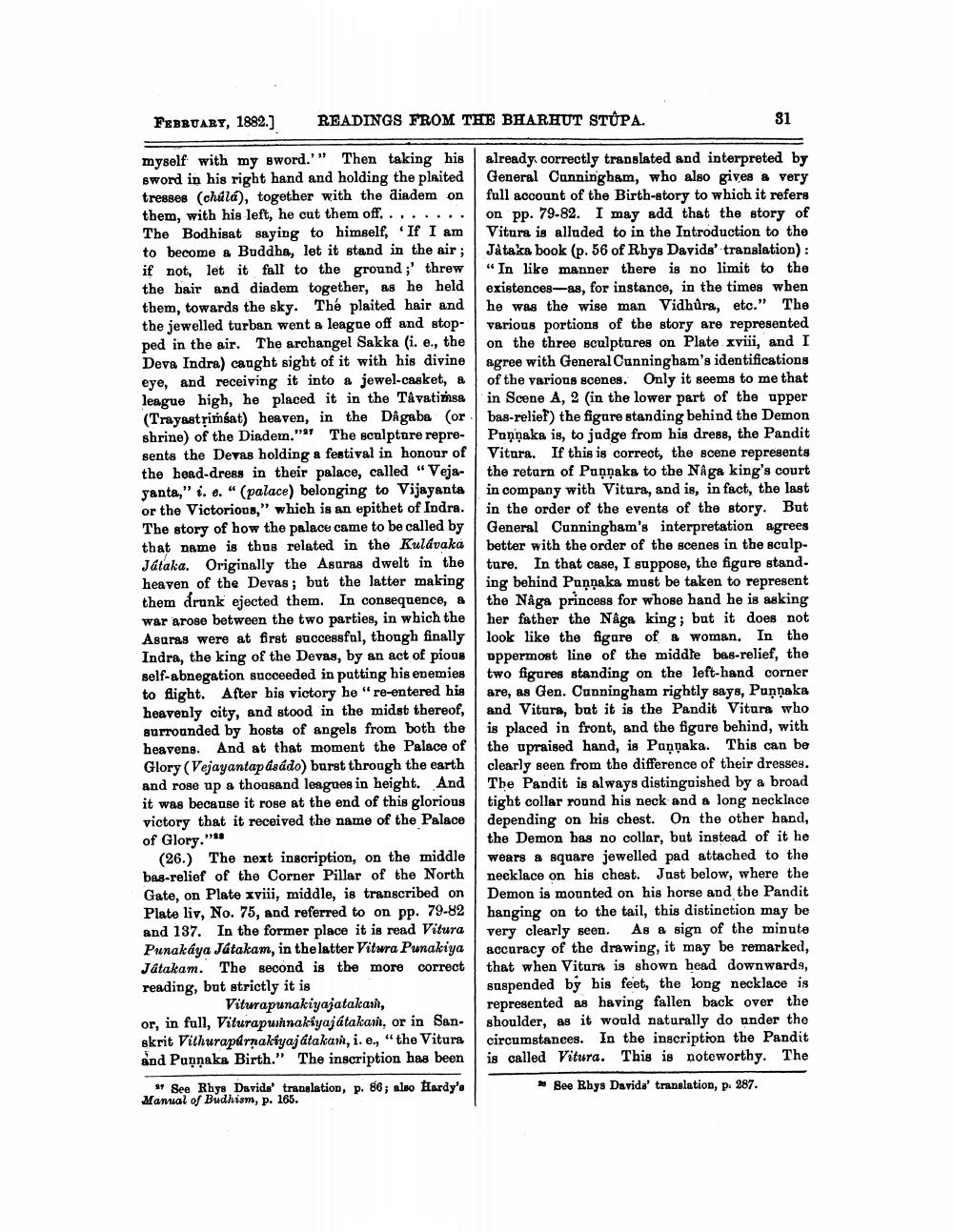________________
FEBRUARY, 1882.)
READINGS FROM THE BHARHUT STÚPA.
31
myself with my sword.' Then taking his already correctly translated and interpreted by sword in his right hand and holding the plaited General Cunningham, who also gives & very tresses (child), together with the diadem on full account of the Birth-story to which it refers them, with his left, he cut them off. ....... on pp. 79-82. I may add that the story of The Bodhisat saying to himself, If I am | Vitura is alluded to in the Introduction to the to become a Buddha, let it stand in the air ; Jåtaka book (p. 56 of Rhys Davids' translation): if not, let it fall to the ground;' threw "In like manner there is no limit to the the bair and diadem together, as he held existences-as, for instance, in the times when them, towards the sky. Thé plaited hair and he was the wise man Vidhura, etc." The the jewelled turban went a league off and stop- various portions of the story are represented ped in the air. The archangel Sakka (i. e., the on the three sculptures on Plate xviii, and I Deva Indra) canght sight of it with his divine agree with General Cunningham's identifications eye, and receiving it into a jewel-casket, a of the various scenes. Only it seems to me that league high, he placed it in the Tâvatimsain Scene A, 2 (in the lower part of the upper (Trayastrimsat) heaven, in the Dagaba (or bas-relief) the figure standing behind the Demon shrine) of the Diadem." The sculptare repre- Paņņaka is, to judge from his dress, the Pandit sents the Devas holding a festival in honour of Vitara. If this is correct, the scene represents the head-dress in their palace, called “ Veja- the return of Punnaks to the Nâga king's court yanta," i. e." (palace) belonging to Vijayanta in company with Vitura, and is, in fact, the last or the Victorious," which is an epithet of Indra. in the order of the events of the story. But The story of how the palace came to be called by General Cunningham's interpretation agrees that name is thus related in the Kulávaka better with the order of the scenes in the sculpJátaka. Originally the Asuras dwelt in the tare. In that case, I suppose, the figure stand. heaven of the Devas; but the latter making ing behind Punnaka must be taken to represent them drunk ejected them. In consequence, a the Någa princess for whose hand he is asking war arose between the two parties, in which the her father the Naga king; but it does not Asaras were at first successful, though finally look like the figure of a woman. In the Indra, the king of the Devas, by an act of pious uppermost line of the middle bas-relief, the self-abnegation succeeded in putting his enemies two figures standing on the left-hand corner to flight. After his victory he "re-entered his are, as Gen. Cunningham rightly says, Puņnaka heavenly city, and stood in the midst thereof, and Vitara, but it is the Pandit Vitara who surrounded by hosts of angels from both the is placed in front, and the figure behind, with heavens. And at that moment the Palace of the upraised hand, is Pannaka. This can be Glory (Vejayantap dsádo) burst through the earth clearly seen from the difference of their dresses. and rose up a thousand leagues in height. And The Pandit is always distinguished by a broad it was because it rose at the end of this glorious | tight collar round his neck and a long necklace victory that it received the name of the Palace depending on his chest. On the other hand, of Glory."
the Demon has no collar, but instead of it he (26.) The next inscription, on the middle wears a square jewelled pad attached to the bas-relief of the Corner Pillar of the North necklace on his chest. Just below, where the Gate, on Plate xviii, middle, is transcribed on Demon is mounted on his horse and the Pandit Plate liv, No. 75, and referred to on pp. 79-82 hanging on to the tail, this distinction may be and 137. In the former place it is read Vitura very clearly seen. As a sign of the minute Punakaya Jatakam, in the latter Vitura Punakiya accuracy of the drawing, it may be remarked, Játakam. The second is the more correct that when Vitura is shown head downwards, reading, but strictly it is
suspended by his feet, the long necklace is Viturapunakiyajatakasi,
represented as having fallen back over the or, in full, Viturapuhnakiyajátakan, or in San shoulder, as it would naturally do under the skrit Vithurapurnakiyaj átakan, i.e., "the Vitura circumstances. In the inscription the Pandit And Punnaka Birth.” The inscription has been is called Vitura. This is noteworthy. The See Rhys Davids' translation, p. 86; aleo Hardy's
Bee Rhys Davids' translation, p. 287. Manual of Budhism, p. 165.




